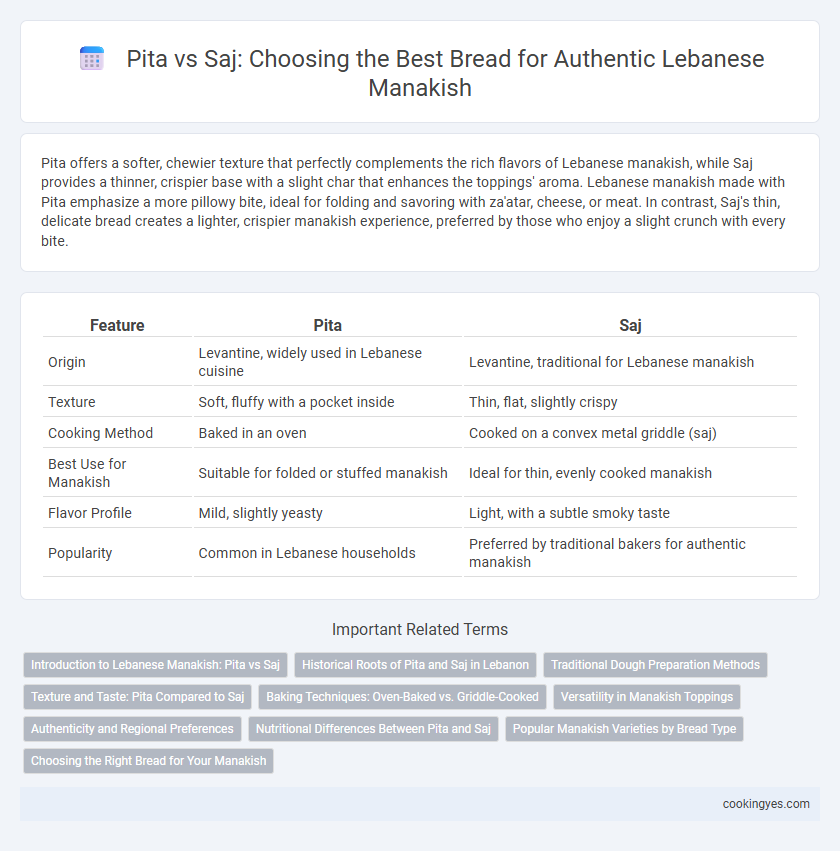Pita offers a softer, chewier texture that perfectly complements the rich flavors of Lebanese manakish, while Saj provides a thinner, crispier base with a slight char that enhances the toppings' aroma. Lebanese manakish made with Pita emphasize a more pillowy bite, ideal for folding and savoring with za'atar, cheese, or meat. In contrast, Saj's thin, delicate bread creates a lighter, crispier manakish experience, preferred by those who enjoy a slight crunch with every bite.
Table of Comparison
| Feature | Pita | Saj |
|---|---|---|
| Origin | Levantine, widely used in Lebanese cuisine | Levantine, traditional for Lebanese manakish |
| Texture | Soft, fluffy with a pocket inside | Thin, flat, slightly crispy |
| Cooking Method | Baked in an oven | Cooked on a convex metal griddle (saj) |
| Best Use for Manakish | Suitable for folded or stuffed manakish | Ideal for thin, evenly cooked manakish |
| Flavor Profile | Mild, slightly yeasty | Light, with a subtle smoky taste |
| Popularity | Common in Lebanese households | Preferred by traditional bakers for authentic manakish |
Introduction to Lebanese Manakish: Pita vs Saj
Lebanese manakish feature a variety of dough bases, with pita and saj being the most popular choices that influence texture and flavor. Pita provides a thicker, pocket-style bread that holds toppings well, while saj offers a thin, crispy flatbread cooked on a convex griddle, giving a distinct charred taste. Understanding these differences is essential for appreciating the diverse experience of traditional Lebanese manakish.
Historical Roots of Pita and Saj in Lebanon
Pita and Saj both hold deep historical roots in Lebanon, with pita bread tracing back to ancient Levantine civilizations where it was baked in clay ovens for its characteristic pocket and soft texture. Saj, traditionally a domed griddle used for making thin flatbreads, reflects Bedouin nomadic culture, emphasizing rapid, high-heat cooking methods that produce delicate, flexible breads ideal for wrapping manakish. Lebanese manakish often showcase a cultural blend, where pita's thick, airy structure contrasts with the thin, crisp quality of saj bread, highlighting diverse culinary traditions tied to regional history and lifestyle.
Traditional Dough Preparation Methods
Traditional Lebanese manakish dough for pita is crafted using a slow fermentation process with natural yeast and high-protein flour, resulting in a soft, airy texture ideal for folding. Saj dough preparation involves a thinner, more elastic mixture that is rolled extremely thin and cooked quickly on a convex metal griddle, producing a flexible, slightly crispy flatbread. The distinct preparation methods reflect regional culinary heritage, with pita emphasizing a puffed pocket suitable for fillings, while saj prioritizes a delicate, pliable surface for layering toppings.
Texture and Taste: Pita Compared to Saj
Pita bread offers a soft, slightly chewy texture that complements the robust flavors of Lebanese manakish, allowing the za'atar and cheese toppings to blend seamlessly with each bite. Saj, on the other hand, is thinner and crispier, providing a crunchier base that enhances the contrast between the crust and the savory toppings. Choosing pita over saj influences the overall eating experience, favoring a more pillowy mouthfeel and a subtle wheat flavor that holds the toppings without overpowering them.
Baking Techniques: Oven-Baked vs. Griddle-Cooked
Pita for Lebanese manakish is traditionally oven-baked, creating a soft, pillowy texture with characteristic puffed pockets ideal for holding toppings. In contrast, Saj bread is griddle-cooked over a domed metal plate, resulting in a thinner, crisper flatbread that lacks the airy pocket of pita. The oven-baking technique allows pita to rise and develop even heat distribution, essential for authentic manakish preparation.
Versatility in Manakish Toppings
Pita bread offers greater versatility for Lebanese manakish toppings due to its slightly thicker, fluffier texture, which better supports a wider range of ingredients including za'atar, cheese, and ground meat without becoming soggy. Saj, being thinner and crispier, is ideal for simpler toppings but may not hold heavy or moist ingredients as effectively. This makes pita the preferred choice for those seeking diverse and hearty manakish options.
Authenticity and Regional Preferences
Lebanese manakish traditionally feature saj bread, prized for its thin, flexible texture and smoky flavor, which enhances authenticity rooted in Levantine culinary heritage. Pita, though widely used, lacks the signature crispness of saj and is often preferred in regions where thicker, softer bread suits local tastes. Regional preferences highlight saj bread in Lebanese coastal areas, while inland populations lean toward pita for convenience and adaptability in manakish preparation.
Nutritional Differences Between Pita and Saj
Pita bread typically contains more fiber and protein due to its whole wheat content, making it a slightly more nutritious option compared to Saj, which is often made from white flour and has higher glycemic index values. Saj, being thinner and crispier, generally has fewer calories per serving but lacks the nutrient density found in pita. For Lebanese manakish, choosing pita can contribute to better sustained energy and digestive health, while saj offers a lighter texture with less satiety.
Popular Manakish Varieties by Bread Type
Lebanese manakish traditionally use pita bread, prized for its soft, pocket-like texture that perfectly holds za'atar, cheese, or minced meat toppings, enhancing flavor absorption. Saj bread, thinner and crisper, offers a lighter alternative often preferred for spinach or labneh manakish, providing a delicate crunch that contrasts with the rich toppings. Popular varieties like za'atar manakish favor pita for its robust structure, while saj suits lighter toppings, reflecting regional preferences in Lebanese culinary traditions.
Choosing the Right Bread for Your Manakish
Choosing the right bread for Lebanese manakish involves understanding the distinct qualities of pita and saj. Pita, with its pocketed, soft texture, is ideal for holding rich fillings and absorbing flavors, making it a staple for classic manakish varieties like za'atar and cheese. Saj offers a thinner, crisper base perfect for a lighter, more delicate manakish experience, emphasizing the freshness of toppings without overwhelming the palate.
Pita vs Saj for Lebanese manakish Infographic

 cookingyes.com
cookingyes.com